UnitII Inheritance and Pointers Prepared By Mr Hule

Unit-II Inheritance and Pointers Prepared By Mr. Hule Kuldeep(ME-CSE)

Unit Objectives Saturday, January 1, 2022 1. Define inheritance relationships between classes, including public, protected, and private inheritance. 2. Learn how to write class definitions and member function definitions for several classes in an inheritance relationship 3. Discuss pointer types and pointer variables. 4. Discuss how to create a permanent or temporary binding between a pointer variable and a data variable. 5. Discuss how to retrieve and change data in a data variable through the pointer variable. 6. Discuss relations between arrays and pointers, and discuss array arithmetic. 7. Discuss relations between arrays and functions, 8. Discuss about how the Firefox & Thunderbird software was developed with the help of C++. 2

Unit Contents Saturday, January 1, 2022 1. Inheritance: ü Inheritance- Base Class and derived Class, protected members, relationship between base Class & derived Class. ü Constructor and destructor in Derived Class, Overriding Member Functions, Public and Private Inheritance ü Types of Inheritance, Class Hierarchies, Ambiguity in Multiple Inheritance, Virtual Base Class, Abstract class, Friend Class, Nested Class. 2. Pointer: ü Pointers, declaring and initializing pointers, indirection Operators, Memory Management: new and delete, ü Pointers to Objects, this pointer, Pointers to Pointers, Null pointer, void pointer, Pointers to Derived classes ü Pointers Vs Arrays, accessing Arrays using pointers, Arrays of Pointers ü Function pointers, Passing pointers to functions, Return pointers from functions 3. Case study: Know about Firefox and Thunderbird as popular softwares developed using C++ 3

Session 8: Introduction to Inheritance Concept 4 Content: 1. Introduction to C++ Inheritance 2. Protected Members 3. Inheritance – Terminology and Notation 4. Relationship between Base class & Derived class 5. Constructor & Destructor in Derived class

Introduction to C++ Inheritance § Provides a way to create a new class from an existing class § The new class is a specialized version of the existing class § Consider Example of Insects. § Concept Video Link 5 Saturday, January 1, 2022

6 class B { ……. . //500 Statements ………. }; Son class A { ……. . //1000 Statements ………. }; Father Grand Father Why Inheritance? Saturday, January 1, 2022 class C { ……. . //500 Statements ………. };

Protected Members Saturday, January 1, 2022 § Private member of a base class cannot be inherited. § Protected members of a base class are like private members, except they may be accessed by derived classes. § Protected members are inaccessible to all other code in the program. § The base class access specification determines how private, protected, and public base class members are accessed when they are inherited by the derived class. 7

Saturday, January 1, 2022 Difference Between Private and Protected in C++ Basis for comparison 8 Private Protected Inheriting property to the derived class Derived class cannot access base class private members. Derived class can access base class protected members. Accessibility Private members of the class are inaccessible out of the class scope. Protected members of the class are inaccessible out of the class scope except the class derived immediately. Accessible from own class Yes Accessible from derived class No Yes Accessible from outside No No

Saturday, January 1, 2022 Inheritance and the Is-a Relationship § When one object is a specialized version of another object, there is an is-a relationship between them. § For example, a grasshopper is an insect. Here a few other examples of the is-a relationship. § A poodle is a dog. § A car is a vehicle. § A flower is a plant § A rectangle is a shape. § When an is-a relationship exists between objects, it means that the specialized object has all of the characteristics of the general object, plus additional characteristics that make it special. § In object-oriented programming, inheritance is used to create an is-a relationship between classes. 9

Saturday, January 1, 2022 Inheritance – Terminology and Notation Derived Class Base Class § Base class (or parent) – inherited from § Derived class (or child) – inherits from the base class § Notation: class Bank 90 s { private: long int accountno, …. . public: void add. Money(); void withdraw. Money(); void take. Loan(); void display. Account. Details(); }; class Bank 20 s : public Bank 90 s { private: accountno, …. public: void online. Money. Transfer(); void online. Pay. Cheques(); }; 10 Object of the derived class has: • all members defined in child class • all members declared in parent class object of the derived class can use: • all public members defined in child class • all public members defined in parent class

Saturday, January 1, 2022 Relationship between Base class & Derived class § Inheritance is important feature in OOP which allows reusability of the code. § Fundamental idea behind the inheritance is that-make use of data members & member functions of base class in derived class along with some additional functionality present in derived class. § Secondly if there are multiple derived classes, & if there is a need for some modifications in the code, then those modifications need to be carried out in all derived classes. § If we use inheritance then repetition of code can be avoided. § Example. 11

Saturday, January 1, 2022 Base Class Vs Derived Class 12

Saturday, January 1, 2022 Class Access Specifiers § public – object of derived class can be treated as object of base class (not vice-versa) § protected – more restrictive than public, but allows derived classes to know details of parents § private – prevents objects of derived class from being treated as objects of base class. 13

Saturday, January 1, 2022 Inheritance vs. Access How inherited base class members appear in derived class Base class members 14 private: x protected: y public: z private base class x is inaccessible private: y private: z private: x protected: y public: z protected base class x is inaccessible protected: y protected: z private: x protected: y public: z public base class x is inaccessible protected: y public: z Concept Video Link

Saturday, January 1, 2022 More Inheritance vs. Access class Grade private members: char letter; float score; void calc. Grade(); public members: void set. Score(float); float get. Score(); char get. Letter(); When Test class inherits from Grade class using public class access, it looks like this: 15 class Test : public Grade private members: int num. Questions; float points. Each; int num. Missed; public members: Test(int, int); private members: int num. Questions: float points. Each; int num. Missed; public members: Test(int, int); void set. Score(float); float get. Score(); float get. Letter();

Saturday, January 1, 2022 More Inheritance vs. Access class Grade private members: char letter; float score; void calc. Grade(); public members: void set. Score(float); float get. Score(); char get. Letter(); When Test class inherits from Grade class using protected class access, it looks like this: 16 class Test : protected Grade private members: int num. Questions; float points. Each; int num. Missed; public members: Test(int, int); private members: int num. Questions: float points. Each; int num. Missed; public members: Test(int, int); protected members: void set. Score(float); float get. Score(); float get. Letter();

Saturday, January 1, 2022 More Inheritance vs. Access class Grade private members: char letter; float score; void calc. Grade(); public members: void set. Score(float); float get. Score(); char get. Letter(); When Test class inherits from Grade class using private class access, it looks like this: 17 class Test : private Grade private members: int num. Questions; float points. Each; int num. Missed; public members: Test(int, int); private members: int num. Questions: float points. Each; int num. Missed; void set. Score(float); float get. Score(); float get. Letter(); public members: Test(int, int);

Saturday, January 1, 2022 Constructors and Destructors in Base and Derived Classes § Derived classes can have their own constructors and destructors § When an object of a derived class is created, the base class’s constructor is executed first, followed by the derived class’s constructor § When an object of a derived class is destroyed, its destructor is called first, then that of the base class § Example. 18

Saturday, January 1, 2022 Passing Arguments to Base Class Constructors § Allows selection between multiple base class constructors § Specify arguments to base constructor on derived constructor heading: § § derived. Class(int x, int y): base. Class(y) Can also be done with inline constructors Must be done if base class has no default constructor It is not necessary that to maintain the sequence. Example. derived class constructor base class constructor derived. Class: : derived. Class(int x, int y): base. Class(y) 19 derived constructor parameter base constructor parameters

Saturday, January 1, 2022 Quiz on Session 8 1. base class and derived class relationship comes under a) b) c) d) Inheritance Polymorphism encapsulation None a) Inheritance 3. Inheritance allow in C++ Program? a) Class Re-usability b) Creating a hierarchy of classes c) Extendibility d) All 20 2. C++ Inheritance relationship is_ a) Association b) Is-A c) Has-A d) None b) Is-A 4. Functions that can be inherited from base class in C++ program a) Constructor b) Destructor c) Static function d) None

Programming Challenges 1. Suppose a program has the following class declarations: class Shape { private: double area; public: void set. Area(double a) { area = a; } double get. Area() { return area; } }; class Circle : public Shape { private: double radius; public: void set. Radius(double r) { radius = r; set. Area(3. 14 * r); } double get. Radius() { return radius; } }; Answer the following questions concerning these classes: a) When an object of the Circle class is created, what are its private members? b) When an object of the Circle class is created, what are its public members? c) What members of the Shape class are not accessible to member functions of the Circle class? 21 2. Saturday, January 1, 2022 Define classes to appropriately represent class hierarchy as shown in Below figure. Use constructors for both classes and display Salary for a particular employee.

Session 9: Types of Inheritance Content: 1. Types of Inheritance 2. Overriding Member Functions 3. Class Hierarchies 4. Ambiguity in Inheritance: 22 1. 2. 3. Ambiguity in Multiple Inheritance: Diamond Problem with Hybrid/Multipath Inheritance Virtual Base Class 5. Friend Class

Inheritance § Inheritance is one of the basic features of object oriented programming. § In the process of inheritance, one object can acquire the properties of another class. Type of class Base Class Definition A class that is inherited is called a base class. In below diagram, the class 'vehicle' is a base class. The class that does the inheriting is called a Derived Class derived class. In below diagram, the class 'car' is a derived class. 23 Saturday, January 1, 2022

Types of Inheritance Single Inheritance Multilevel Inheritance Multiple Inheritance Hierarchical Inheritance Hybrid Inheritance 24 Saturday, January 1, 2022

Single Inheritance Saturday, January 1, 2022 § In this type of inheritance, one Derived class is formed by acquiring the properties of one Base class. Class Name Type A Base class Derived B class Explanation It is base class in the above program Class derives the properties of class A Let us Understand with Example 25

Multilevel Inheritance Saturday, January 1, 2022 § In this type of inheritance, derived class is formed by acquiring the properties of one base class. § Again same derived class is used as a base class and another class is derived from this. Class Name Type Explanation A Base class It is base class in the above program B Base class for C and derived class for A - C Derived class It contains all the properties of class A and B so we can consider this as derived class of A also 26 Example

Multiple Inheritance Saturday, January 1, 2022 § In this type of inheritance, one Derived class is formed by acquiring the properties of multiple Base classes. Class Name A B C 27 Type Base class Derived class Explanation It is base class in the above program Class derives the properties of class A and B Lets understand with Example

Hierarchical Inheritance Saturday, January 1, 2022 § In this type of inheritance, multiple subclass are formed by acquiring the properties of one Base class. Class Name A B C D 28 Type Base class Derived class Explanation It is base class in the above program Class derives the properties of class A Lets understand with Example

Hybrid Inheritance Saturday, January 1, 2022 § In this type of Inheritance, the Derived class is formed by any legal combination of above four forms. 29 Lets understand with Example

Problem Statement Saturday, January 1, 2022 Create Student bio-data using following classes & Multiple inheritance concept of C++. 30

Class Hierarchies § Inheritance is a mechanism in which using base Saturday, January 1, 2022 Undergraduate class, various classes can be derived. § The class hierarchy is normally represented by Student Masters class diagram. § Implementation of class hierarchy is possible using Hierarchical Inheritance. Ph. D Person Teaching Staff Non-Teaching Staff 31

Overriding Member Functions § It is the redefinition of base class function in its derived class with same signature i. e. return type and parameters. § But the task carried out with it is different. It can only be done in derived class. § Let's see a simple example of Function overriding in C++ § How to access the overridden function in the base class from the derived class? § To access the overridden function of the base class from the derived class, scope resolution operator : : is used. For example, § If you want to access get. Data() function of the base class, you can use the following statement in the derived class. Base: : get. Data(); 32

Saturday, January 1, 2022 Ambiguity in Multiple Inheritance 34

Diamond Problem with Hybrid/Multipath Inheritance Saturday, January 1, 2022 § Two ways to avoid C++ ambiguity: 1. Using scope resolution operator 2. Using virtual base class 35

Virtual Base Class § The duplication of inherited members due to multiple paths can be avoided by making the common base class(ancestor class) as virtual base class while declaring the direct or intermediate base classes. 36 class_A { ……. . }; class_B : virtual public class_A { ……. . }; class_C : virtual public class_A { ……. . }; class_D : public class_B, public class_C { ……. . // only one copy of class_A will be inherited ……. . };

Abstract Class Saturday, January 1, 2022 § Sometimes implementation of all function cannot be provided in a base class because we don’t know the implementation. Such a class is called abstract class § A pure virtual function (or abstract function) in C++ is a virtual function for which we don’t have implementation, we only declare it. § A pure virtual function is declared by assigning =0 in declaration. class Weapon { public: virtual void features() = 0; }; 37 This pure virtual function And, the class Weapon is an abstract class.

Abstract Class Example #include <iostream> using namespace std; class Shape // Abstract class { protected: float l; public: void get. Data() { cin >> l; } // pure virtual Function virtual float calculate. Area() = 0; }; class Square : public Shape { public: float calculate. Area() { return l*l; } }; 38 class Circle : public Shape { public: Output float calculate. Area() Enter length to calculate the area of a square: 4 { return 3. 14*l*l; } }; Area of square: 16 int main() Enter radius to calculate the area of a circle: 5 { Area of circle: 78. 5 Square s; Circle c; cout << "Enter length to calculate the area of a square: "; s. get. Data(); cout<<"Area of square: " << s. calculate. Area(); cout<<"n. Enter radius to calculate the area of a circle: "; c. get. Data(); cout << "Area of circle: " << c. calculate. Area(); return 0; } Saturday, January 38 1, 2022

Friend Class Saturday, January 1, 2022 § Like friend function, a class can also be a friend of another class. § A friend class can access all the private and protected members of other class. § In order to access the private and protected members of a class into friend class we must pass on object of a class to the member functions of friend class. § For example: class B; class A { friend class B; . . . . // class B is a friend class of class A } class B {. . . . } § All member functions of class B will be friend functions of class A. § Thus, any member function of class B can access the private and protected data of class A. But, member functions of class A cannot access the data of class B. 39

Friend Class Example #include<iostream> using namespace std; class Rectangle { int L, B; public: Rectangle() { L=10; B=20; } friend class Square; }; 40 class Square { int S; public: Square() { S=5; } void Display(Rectangle Rect) { cout<<"nnt. Length : "<<Rect. L; cout<<"nnt. Breadth : "<<Rect. B; cout<<"nnt. Side : "<<S; } }; int main() { Rectangle R; Square S; S. Display(R); //Statement 2 } Output Length : 10 Breadth : 20 Side : 5 Saturday, January 40 1, 2022

Saturday, January 1, 2022 Difference Between Friend Function and Friend Class Basis for comparison Friend Function Friend Class Basic It is a function used with a friend keyword to grant a non-member function access to the private members of a class. It is a class used with a friend keyword to access the private members of another class. Forward declaration Must be used. Not mandatory. Use A friend function can be used in some situation of operator overloading. A friend class can be used when a class is created on the top of another class. 41

Local Classes § A class defined within a function is called Local Class. Syntax: void function() { class_name { // class definition } obj; //function body } 42 void fun() { class myclass { int i; public: void put_i(int n) { i=n; } int get_i() { return i; } } ob; ob. put_i(10); cout << ob. get_i(); } Saturday, January 1, 2022

Nested Classes Syntax: class outer_class { //class definition class inner_class { //class definition }; }; 43 Example: Class. X{…. . }; Class. Y{…. }; Class. Z{ X Ob 1; Y Ob 2; }; Saturday, January 1, 2022 Example: class student { int st_id; public: class dob { public: int dd, mm, yy; }dt; void read() //object of X class { dt. dd=25; //object of Y class dt. mm=2; dt. yy=1988; } };

Saturday, January 1, 2022 Why Class within Class instead Inheritance 1. C++ code using multiple inheritance tends to be a bit difficult to maintain. 2. Inheritance locks in a class’s behavior at link time, while class within class allows you to change the behavior of a class during runtime. 3. When you inherit from a class its internals are visible to you. On the other hand, with composite classes the internals of the class you compose with are hidden. 44

Summary of Inheritance Saturday, January 1, 2022 1. Inheritance is the capability of one class to inherit the properties of another class. 2. Inheritance supports reusability of code and is able to simulate the transitive nature of real life objects. 3. A class from which another class is inheriting its properties is called base class and the class inheriting properties is known as a sub class or derived class. 4. When a class inherits from a single class it is known as single inheritance. 5. When a class inherits from multiple base classes it is known as multiple inheritance. 6. When several classes inherit from the same class it is hierarchical inheritance. 7. When a subclass is the base class of another class it is known as multilevel inheritance. 45

Summary of Inheritance Saturday, January 1, 2022 8. When a class inherits from multiple base classes and all of its base classes are subclasses of the same 9. 10. 11. 12. 13. 14. 46 class it is hybrid inheritance. In the publicly derived class the public and protected members of the base class remains same. The derived class constructor is responsible for invoking (and passing arguments to) the base class constructor. The derived class can directly access only the public and protected members of the base class. To make the private member of a class inheritable declare it under protected section of the base class. When a class inherits from more than one base class this is called multiple inheritance. When a derived class and its base class have common ancestor then ambiguity may arise as the derived class contains multiple copies of common ancestor. This can be resolved either by using scope resolution operator : : or by declaring the common ancestor as virtual.

Saturday, January 1, 2022 Quiz on Session 9 1. Virtual Base class __ a) Allows to inherit more than 1 copy of the base class members b) Strict the path of inheritance c) Is qualified as virtual in base class definition d) None of these c) Is qualified as virtual in base class definition 3. Composition is referred to as _______ a) “is a” relationship b) “extends to” relationship c) Both A & B d) “has a” relationship 47 2. When 2 or more classes are used within another class definition, it is called _____ a) b) c) d) Inheritance Aggregation Both A & B None of these b) Aggregation 4. Pure virtual functions _____ a) Have to be redefined in the inherited class b) Cannot have public access specification c) Are mandatory for a virtual class d) None of these a) Have to be redefined in the inherited class

Programming Challenges 2. 48 Write a program to implement following inheritance as shown in Figure. Accept and display data for one object of class result. 2. Saturday, January 1, 2022 Write C++ program for following multilevel inheritance. Accept and display data for one car with all details.

Session 10: Pointers in C++ Contents: 1. Getting the Address of a Variable 2. Pointers-Indirection operator 1. 2. Initialization of Pointer Variable Accessing variable through Pointer 3. Dynamic Memory Management using new & delete operator 4. Pointers to Objects 49

Saturday, January 1, 2022 Getting the Address of a Variable § CONCEPT: The address operator (&) returns the memory address of a variable. § Every variable is allocated a section of memory large enough to hold a value of the variable’s data type. § On a PC, for instance, it’s common for one byte to be allocated for chars, two bytes for shorts, four bytes for ints, longs, and floats, and eight bytes for doubles. Each byte of memory has a unique address. § A variable’s address is the address of the first byte allocated to that variable. § Suppose the following variables are defined in a program: char letter; short number; float amount; 50

Saturday, January 1, 2022 Getting the Address of a Variable Continued. . § When the address operator (&) is placed in front of a variable name, it returns the address of that variable. § Here is an expression that returns the address of the variable num: &num § And here is a statement that displays the variable’s address on the screen: cout << # § NOTE: Don’t confuse the address operator with & symbol used when defining a reference variable 51 /*This program uses the & operator to determine a variable's address and the sizeof operator to determine its size. */ #include <iostream> using namespace std; int main() { int x = 25; cout << "The address of x is " << &x << endl; cout << "The size of x is " << sizeof(x) << " bytesn"; cout << "The value in x is " << x << endl; return 0; } NOTE: The address of the variable x is displayed in hexadecimal. This is the way addresses are normally shown in C++.

Saturday, January 1, 2022 Get the Value from the Address Using Pointers § CONCEPT: Pointer variables , which are often just called pointers , are designed to hold memory addresses. § § § 52 With pointer variables you can indirectly manipulate data stored in other variables. Like any variable or constant, you must declare a pointer before you can work with it. The general form of a pointer variable declaration is: type *var-name; When * is used with pointers, it's called the dereference operator. It operates on a pointer and gives the value pointed by the address stored in the pointer. Examples of valid Pointer Variables: int *ip; // pointer to an integer double* dp; // pointer to a double float *fp; // pointer to a float char *ch ; // pointer to character

Advantages of Pointer Saturday, January 1, 2022 1. Allows to pass variables, arrays, functions, strings & structures as function arguments. 2. Allows to returns structure variables from functions. 3. Supports dynamic allocations and deallocations of memory. 4. Variables can be swapped without physically moving them. 5. Allows to establish links between data elements or objects for some complex data structures like sack, queue, LL, tree, etc. 53 53

Saturday, January 1, 2022 Operations on Pointers Variables § There are few important operations, which we will do with the pointers very frequently. a) We define a pointer variables b) Assign the address of a variable to a pointer c) Finally access the value at the address available in the pointer variable. 54

Saturday, January 1, 2022 Initialization of Pointer Variable § CONCEPT: Pointers may be initialized with the address of an existing object. Memory address: 1020 … 1024 88 1032 100 … a int a = 100; int *p = &a; cout << a << " " << &a <<endl; cout << p << " " << &p <<endl; § The value of pointer p is the address of variable a with code p=&a. § A pointer is also a variable, so it has its own memory address 55 … 1024 p Result is: 100 1024 1032

Pointer Assignment Saturday, January 1, 2022 § A pointer is variable data type & hence general rule to assign is value to the pointer which is same as that of an variable data type. § Example: Valid Assignments int a, b, *p 1, *p 2; p 1=&a; 56 Invalid Assignments int a; int a_p; a_p=&a; int a, b, *p 1, *p 2; p 1=&x; p 2=p 1; float b; float *b_p; b_p=b; int a, b, *p 1, *p 2; b=*p 1; int a; char *c_p; c_p=&a;

Accessing variable through Pointer (Indirection Operation) § CONCEPT: The real benefit of pointers is that they allow you to indirectly access and modify the variable being pointed to. § This is done with the indirection operator, which is an asterisk (*). § When the indirection operator is placed in front of a pointer variable name, it dereferences the pointer. § When you are working with a dereferenced pointer, you are actually working with the value the pointer is pointing to. 57

Don’t get confused Saturday, January 1, 2022 § Declaring a pointer means only that it is a pointer: int *p; § Don’t be confused with the dereferencing operator, which is also written with an asterisk (*). They are simply two different tasks represented with the same sign int a = 100, b = 88, c = 8; int *p 1 = &a, *p 2, *p 3 = &c; p 2 = &b; // p 2 points to b p 2 = p 1; // p 2 points to a b = *p 3; //assign c to b *p 2 = *p 3; //assign c to a cout << a << b << c; 58 Result is: 888

Saturday, January 1, 2022 A Pointer Example The code Box diagram main void double. It(int x, int * p) { a 16 *p = 2 * x; } int main(int argc, const char * argv[]) { int a = 16; double. It(9, &a); return 0; } a gets 18 59 x p 9 p (8200) 8192 double. It x (8196) 9 a (8192) 16 main

Saturday, January 1, 2022 Debugging of Pointers: Null Pointer § In C++ 11, the nullptr keyword was introduced to represent the address O. § So, assigning nullptr/NULL to a pointer variable makes the variable point to the address O. § When a pointer is set to the address O, it is referred to as a null pointer because it points to “nothing. ” § Here is an example of how you define a pointer variable and initialize it with the value nullptr: int *ptr = nullptr; NOTE: If you are using an older compiler that does not support the C++ 11 standard, you should initialize pointers with the integer 0, or the value NULL. The value NULL is defined in the iostream header file (as well as other header files) to represent the value O. 60

Saturday, January 1, 2022 Example for NULL Pointer // This program stores the address of a variable in a pointer. #include <iostream> using namespace std; int main() { int x = 25; // int variable int *ptr = NULL; // Pointer variable, can point to an int ptr = &x; // Store the address of x in ptr cout << "The value in x is " << x << endl; cout << "The address of x is " << ptr << endl; return 0; } Program Output: The value in x is 25 The address of x is 0 x 7 e 00 61 § To check for a null pointer you can use an if statement as follows: if(ptr) // succeeds if p is not null if(!ptr) // succeeds if p is null

Saturday, January 1, 2022 Dynamic Memory Allocation: new operator § CONCEPT: Variables may be created and destroyed while a program is running. § The program to create our own variables “on the fly” is called dynamic memory allocation and is only possible through the use of pointers. § Dynamically memory allocation is done through new operator at the runtime. § Assume a program has a pointer to an int defined as int *iptr = NULL; § Here is an example of how this pointer may be used with the new operator: iptr = new int; § This statement is requesting that the computer allocate enough memory for a new int variable. § The operand of the new operator is the data type of the variable being created. § Once the statement executes, iptr will contain the address of the newly allocated memory. 62

Saturday, January 1, 2022 Dynamic Memory Allocation: new operator Continued…. § A value may be stored in this new variable by dereferencing the pointer: *iptr = 25; § Any other operation may be performed on the new variable by simply using the dereferenced pointer. § Here are some example statements: // Display the contents of the new variable. cout << *iptr; // Let the user input a value. cin >> *iptr; // Use the new variable in a computation. total += *iptr; 63

Saturday, January 1, 2022 Dynamic Array § A more practical use of the new operator is to dynamically create an array. § Here is an example of how a 100 -element array of integers may be allocated: iptr = new int[100]; § Once the array is created, the pointer may be used with subscript notation to access it. For instance, the following loop could be used to store the value 1 in each element: for (int count = 0; count < 100; count++) iptr[count] = 1; § When memory cannot be dynamically allocated, C++ throws an exception and terminates the program. Throwing an exception means the program signals that an error has occurred. 64

Saturday, January 1, 2022 Dynamic Memory Deallocation: delete operator § When a program is finished using a dynamically allocated chunk of memory, it should release it for future use. § The delete operator is used to free memory that was allocated with new. § Here is an example of how delete is used to free a single variable, pointed to by iptr : delete iptr; § If iptr points to a dynamically allocated array, the [] symbol must be placed between delete and iptr : delete [] iptr; § Failure to release dynamically allocated memory can cause a program to have a memory leak. § WARNING! Only use pointers with delete that were previously used with new. If you use a pointer with delete that does not reference dynamically allocated memory, unexpected problems could result! 65 Let’s Take an Example

Pointers to Objects Saturday, January 1, 2022 § CONCEPT: Pointers and dynamic memory allocation can be used with class objects and structures. § Pointers can be defined to hold the address of an object, which is created statically or dynamically 33, Joseph void read_data( ) void print_data( ) st 2 FCDA 4 66 Statically created object: student *stp; stp = &st; Dynamically created object: student *stp; stp = new student;

Saturday, January 1, 2022 Pointers to Objects – Accessing Members § To access the members of the student object through the pointer st. Because *st is just another way of accessing st, you might think that the expression *st. st_name § will access st. st_name, but this is not so. § To get it right, you must use parentheses to force the indirection operator * to be applied first, as shown here: (*st). st_name § The following statements will correctly set the values of the Student to Kuldeep and 30. (*st). st_name=“Kuldeep”; (*st). st_age=30; 67

Saturday, January 1, 2022 Pointers to Objects – Accessing Members § To solve this problem, C++ provides the structure pointer operator -> is to use when you want to access a member of a class object through a pointer. It consists of a hyphen - and a greater than symbol > written next to each other to look like an arrow. § Using this operator, you can set the name & age of the student with these statements: st->name=“Kuldeep”; st->age=30; § Also you can call class member methods through arrow operator as: st->get. Name(); st->get. Age(); 68

Saturday, January 1, 2022 Accessing Private Members of class using Pointer § We can’t access the private members of the class from outside. We need to make use of the public function. § However, we can return the address of the private member to main & using pointer variable this private member can be accessed. § For example: #include<iostream> using namespace std; class Testing { private: int i; public: void put(){ cout<<"n Enter Some value: "; cin>>i; } int *get() { return &i; } }; 69 int main() { Testing t; t. put(); int *p=t. get(); int a=*p; cout<<"n Value of i: "<<a; *p=100; a=*p; cout<<"n Modified value of i: "<<a; return 0; }

Quiz on Session Saturday, January 1, 2022 1. Write a statement that displays the address of the variable count. Answer: cout<<“Address of the count variable is ”<<&count; 2. Write the definition statement for a variable flt. Ptr. The variable should be a pointer to a float. And point to another float variable. Answer: float a=5. 6 f; float *flt. Ptr=&a; 3. List three uses of the * symbol in C++. Answer: Used as multiplication operator, Used to declare pointer variable, Used as dereference operator, Used with assignment operator. 4. Rewrite the following loop so it uses pointer notation (with the indirection operator) instead of subscript notation. for (int x = 0; x < 100; x++) cout << arr[x] << endl; Answer: for(int x = 0; x < 100; x++) cout << *(arr+x) << endl; 5. What is a null pointer? Answer: A pointer that contains the address 0. 70

Session 11: Pointer & Array Contents: 1. Pointer Arithmetic 2. Accessing Arrays using Pointers 3. Array of Pointer 4. Pointer to String 71

Pointer Arithmetic Saturday, January 1, 2022 § Pointer arithmetic is especially useful with arrays because the elements in an array occupy consecutive memory addresses. § C++ Supports 4 arithmetic operations as: 1. Addition(+) 2. Subtraction(-) 3. Incrementation (++) 4. Decrementation (--) § Pointer are not permitted to perform following arithmetic operations: 1. To multiply or Divide 2. To operates the bitwise shift and mask operations 3. To add or Subtract type float or double to pointers. 72

Saturday, January 1, 2022 Pointer Arithmetic Continued… § Let us consider that ptr is an integer pointer which points to the address 1000. § Assuming 32 -bit integers, let us perform the following arithmetic operation on the pointer: ptr++ § the ptr will point to the location 1004 because each time ptr is incremented, it will point to the next integer. § Note : § ptr + 1 does not return the memory address after ptr, but the memory address of the next object of the type that ptr points to. § Pointers contain addresses. Adding two addresses makes no sense. 73

Pointer Comparisons Saturday, January 1, 2022 § C++’s relational operators may be used to compare pointer values. § Pointers may be compared by using any of C++’s relational operators: > < == != >= <= § NOTE: Comparing two pointers is not the same as comparing the values the two pointers point to. if (ptr 1 < ptr 2) Compares the addresses of the pointed variables respectively. § The following statement, however, compares the values that ptr 1 and ptr 2 point to: if (*ptr 1 < *ptr 2) Compares the values of the pointed variables respectively. 74

Saturday, January 1, 2022 Pointer Arithmetic with Increment & Decrement 75 Operation Description P++ P=P + sizeof(data-type) – Execute before then increment ++P P=P + sizeof(data-type) – Increment before then execute P-- P=P - sizeof(data-type) – Execute before then decrement --P P=P - sizeof(data-type) – Decrement before then execute *(P++) Reprieve contents before then increment *(++P) Increment before then Reprieve contents (*P)++ Increment contents of location pointed by P ++(*P) Increment contents of location pointed by P depending on type of contents. *(P--) Reprieve contents before then Decrement *(--P) Decrement before then Reprieve contents (*P)-- Decrement contents of location pointed by P --(*P) Decrement contents of location pointed by P depending on type of contents.

Saturday, January 1, 2022 Accessing Arrays using Pointers § CONCEPT: Array names can be used as constant pointers, and pointers can be used as array names. § This means that an array name is really a pointer. § Pointers are meant for storing the address of the variable. The pointer can point to any cell of array. § For example: int *ptr; int v[3]; ptr= &a[1]; //address of 1 st element of array a is stored in pointer variable. § It is possible to store the base address of array to pointer variable and entire array can be scanned using this pointer variable. 76 int main() { int v[3], *ptr; int i; ptr=&v[0]; //storing base address of array cout<<"nt Address of an array: "; for(i=0; i<3; i++) cout<<"nt The v["<<i<<"] is: "<<&v[i]; cout<<"nt Address using pointer: n"; for(i=0; i<3; i++) cout<<"nt The ptr#"<<i<<" is: "<<ptr+i; return 0; }

Saturday, January 1, 2022 Accessing Arrays using Pointers § Consider the declaration § § int v[20], *p; And Valid assignment: p=&v[0]; In C++, when you add a value to a pointer, you are actually adding that value times the size of the data type being referenced by the pointer. In other words, if you add one to numbers, you are actually adding 1 * sizeof(datatype) to numbers. Then following are some of the valid equalities for accessing array : § p++==&v[1] § *p==v[0] § *(p+5)==&v[5] 77

Saturday, January 1, 2022 Accessing Arrays using Pointers ü When working with arrays, remember the following rule: array[index] is equivalent to *(array + index ) 78

Problem Statement Saturday, January 1, 2022 1. WAP to demonstrate the use of relational operator to compare the pointer variable. 2. WAP to search a number from an array using pointer to array. 3. WAP to update a number at location of array using pointer to array. 4. WAP to delete a number at location of array using pointer to array. 79

Array of Pointers Saturday, January 1, 2022 § Syntax for array of pointers to an integer: § int *arr[MAX]; § This declares ptr as an array of MAX integer pointers. Thus, each element in ptr, now holds a pointer to an int value. 80 #include <iostream> using namespace std; int main () { int var[3] = {10, 100, 200}; int *ptr[3]; for (int i = 0; i < 3; i++) ptr[i] = &var[i]; // assign the address of integer. for (int i = 0; i < 3; i++) { cout << "Value of var[" << i << "] = "; Output: cout << *ptr[i] << endl; Value of var[0] = 10 } Value of var[1] = 100 return 0; Value of var[2] = 200 } Working of C++ Pointers with Arrays

Saturday, January 1, 2022 Pointer to String § String is nothing but array of characters terminated by special character ‘�’. § Pointer to string is a pointer to character datatype which points to the base address of string. § Syntax for declaring pointer to string: char *pointer_variable_name; § If string is char str[10] & pointer is: char *ptr; § Then to initialize pointer use either: ptr=str; Or ptr=str[0]; 81

Saturday, January 1, 2022 82 #include<iostream> using namespace std; int main() { char *p, str[15]; int length=0; cout<<"Enter the string: "; cin>>str; p=str; Output: while(*p!='�') Enter the string: AIT, Pune { Length of String: 8 length++; p++; } cout<<"n Length of String: "<<length; return 0; }

Saturday, January 1, 2022 String Operations using Pointer § Following are the various Operations performed on String: 1. Finding Length of String 2. String Copy 3. String concatenation 4. String comparison 5. String reverse 83

Quiz on Session 11 1. What will be the output of the following C++ code? #include <iostream> using namespace std; int main() { int a = 5, b = 10, c = 15; int *arr[ ] = {&a, &b, &c}; cout << arr[1]; return 0; } a) b) c) d) 5 10 15 it will return some random number d) it will return some random number 84 Saturday, January 1, 2022 2. What will be the output of the following C++ code? #include <iostream> using namespace std; int main() { char arr[20]; int i; for(i = 0; i < 10; i++) *(arr + i) = 65 + i; *(arr + i) = '�'; cout << arr; return(0); } a) ABCDEFGHIJ b) AAAAA c) JJJJ d) AAAAAAJJJJ a) ABCDEFGHIJ

Programming Challenges Saturday, January 1, 2022 1. WAP that counts number of vowels in a string. 2. WAP to find number of occurrences of a character in string. 3. WAP to Find the Number of Vowels, Consonants, Digits and White Spaces in a String. 85

Session 12: Variety in Pointers Contents: 1. Pointer to Pointer 2. this Pointer 3. Void Pointer 4. Smart Pointer: Unique, Shared & Temporary 86

Pointer to Pointer § Form of multiple indirection or a chain of pointers. § Also called Double Pointer. § It can declared as: 87 Datatype **pointer_variable_name; Saturday, January 1, 2022

Working of Pointer to Pointer Saturday, January 1, 2022 ++ 88 Programming Example

this Pointer Saturday, January 1, 2022 § To understand ‘this’ pointer, it is important to know how objects look at functions and data members of a class. 1. Each object gets its own copy of the data member. 2. All-access the same function definition as present in the code segment. § The this pointer points to the object that invoked the function § When a member function is called with an object, it is automatically passed an implicit argument that is a pointer to the invoking object (that is, the object on which the function is called). § If 2 variable names are same that time we can use this pointer to differentiate between variables. § It is also useful for returning current object. 89

this Pointer Example 90 #include<iostream> using namespace std; class Test{ int cnt; public: Test(){} Test(int cnt){ this->cnt=cnt; } void print() { cout<<cnt; } Test &add(Test &a, Test &b){ cnt=a. cnt; cout<<"n Assignment operator invoked. "; return *this; } }; int main() { Test a(15), x, y; y=x=a; //invoke overloaded =, twice cout<<"n x: "; x. print(); cout<<"n y: "; y. print(); return 0; } Output: Assignment operator invoked. x: 15 y: 15 Programming Example

Void Pointer Saturday, January 1, 2022 § The void pointer, also known as the generic pointer, § Is a special type of pointer that can be pointed at objects of any data type! § A void pointer is declared like a normal pointer, using the void keyword as the pointer’s type: void *ptr; // ptr is a void pointer § A void pointer can point to objects of any data type: int n. Value; float f. Value; struct Something{ int n; } s. Value; void *ptr; ptr = &n. Value; // valid ptr = &f. Value; // valid ptr = &s. Value; // valid 91 Programming Example

Saturday, January 1, 2022 Void pointer continued… § Because the void pointer does not know what type of object it is pointing to, it cannot be dereferenced directly! § Rather, the void pointer must first be explicitly cast to another pointer type before it is dereferenced. int value = 5; void *void. Ptr = &value; cout << *void. Ptr << endl; // illegal: can’t dereference a void pointer int *int. Ptr = static_cast<int*>(void. Ptr); // however, if we cast our void pointer to an int pointer. . . cout << *int. Ptr << endl; // then we can dereference it like normal This prints: 5 92

Dangling Pointer Problem § Generally, daggling pointers arise when the referencing object is deleted or deallocated, without changing the value of the pointers. int *A = new int[5]; for(int i=0; i<5; i++) A[i] = i; int *B = A; delete [] A; B[0] = 1; // illegal! 93

Memory Leak Problem § a memory leak occurs when you forget to deallocate the allocated memory. int *A = new int [5]; for(int i=0; i<5; i++) A[i] = i; A 0 1 2 2 3 4 A = new int [5]; 94

Saturday, January 1, 2022 Smart Pointer: to Avoid Memory Leaks § Concept: objects that work like pointers, but have the ability to automatically delete dynamically allocated memory that is no longer being used. § Objects that look and feel like pointers, but are smarter. § Smart pointer is a class with overloaded operator like dereferencing (operator *) and indirection (operator ->). § Smart pointers need to do things that regular pointers don’t. § In smart pointer, the operator overloading is used to mimic the behavior of traditional pointers along with memory management operations. § Three types of smart pointer: unique_ptr or auto_ptr , shared_ptr , and weak_ptr. 95

Saturday, January 1, 2022 Why should I use Smart Pointer ? § Automatic cleanup. Object destruction is done automatically. § Automatic initialization. You don't need to initialize the object. since the default constructor does that for you. This is one less thing for the programmer to forget. § Dangling pointers. A common pitfall of regular pointers is the dangling pointer: a pointer that points to an object that is already deleted. § A smart pointer automatically deletes a chunk of dynamically allocated memory when the memory is no longer being used. This helps to prevent memory leaks from occurring. 96

#include<iostream> #include<string> using namespace std; class Employee { int eid; string ename; public: Employee(){ } Employee(string name, int id){ eid=id; ename=name; } void display() { cout<<"nt Employee ID: "<<eid; cout<<"nt Employee Name: "<<ename; } }; Output: 97 Employee Details using Smart Pointer: Employee ID : 1611 Employee Name: Kuldeep Hule class Pointer{ Employee *ptr; public: Pointer(Employee *p){ ptr=p; } ~Pointer() { delete ptr; } Employee *operator ->(){ return ptr; } Employee &operator *() { return *ptr; } }; int main(){ Pointer p(new Employee("Kuldeep Hule", 1611)); cout<<"nt Employee Deatails using Smart Pointer: "; p->display(); return 0; }

Saturday, January 1, 2022 Unique ownership (std: : auto_ptr) Pointer § A std: : auto_ptr is a class template that manages the lifetime of a § § § § 98 dynamically stored object. the dynamic object is owned by only one instance of a std: : auto_ptr at any time Here is an example: auto_ptr<int> ptr( new int ); This statement defines a auto_ptr named ptr that points to a dynamically allocated int. Here are some details about the statement: The notation <int> that appears immediately after auto_ptr indicates that the pointer can point to an int. The name of the pointer is ptr. The expression new int that appears inside the parentheses allocates a chunk of memory to hold an int. The address of the chunk of memory will be assigned to the ptr pointer. // This program demonstrates a auto_ptr. #include <iostream> #include <memory> using namespace std; int main() { // Define a auto_ptr smart pointer, pointing // to a dynamically allocated int. auto_ptr<int> ptr( new int ); // Assign 99 to the dynamically allocated int. *ptr = 99; // Display value of the dynamically allocated int. cout << *ptr << endl; return 0; } Output: 99

Saturday, January 1, 2022 Sharing ownership (std: : shared_ptr) Pointer § The class template std: : shared_ptr defines a shared pointer that is able to share ownership of an object with other shared pointers. § The sharing behavior is implemented through a technique known as reference counting, where the number of shared pointers that point to the object is stored alongside it. § When this count reaches zero, either through the destruction or reassignment of the last std: : shared_ptr instance, object is automatically destroyed. std: : shared_ptr<Test> first. Shared (new Test(/*args*/)); // Creation: 'first. Shared' is a shared pointer for a new instance of ‘Test' § To create multiple smart pointers that share the same object, we need to create another shared_ptr that aliases the first shared pointer. Here are 2 ways of doing it: std: : shared_ptr<Test> second. Shared(first. Shared); // 1 st way: Copy constructing std: : shared_ptr<Test> second. Shared; second. Shared = first. Shared; // 2 nd way: Assigning § Either of the above ways makes second. Shared a shared pointer that shares ownership of our instance of Test with first. Shared. 99

#include<iostream> #include<memory> using namespace std; class Test { int n; public: Test(int a) { n=a; } ~Test() { cout<<"nt Deleting "<<n; } int get() { return n; } }; 100 int main() { Test *a=new Test(10); Test *b=new Test(20); Test *c=a; cout<<"nt a: "<<a->get(); cout<<"t b: "<<b->get(); cout<<"t c: "<<c->get(); delete a; delete b; delete c; return 0; } Output: Without Shared_ptr a: 10 b: 20 c: 10 Deleting 20 Deleting 13834832 Process exited with return value 3221226356

#include<iostream> #include<memory> using namespace std; class Test { int n; public: Test(int a) { n=a; } ~Test() { cout<<"nt Deleting "<<n; } int get() { return n; } }; 101 int main() { shared_ptr<Test> a(new Test(10)); shared_ptr<Test> b(new Test(20)); shared_ptr<Test>c=a; cout<<"nt a: "<<a->get(); cout<<"t b: "<<b->get(); cout<<"t c: "<<c->get(); return 0; } Output: With Shared_ptr a: 10 b: 20 c: 10 Deleting 20 Deleting 10 Process returned 0 (0 x 0)

Saturday, January 1, 2022 Sharing with temporary ownership (std: : weak_ptr) Pointer § Instances of std: : weak_ptr can point to objects owned by instances of std: : shared_ptr while only becoming temporary owners themselves. § This means that weak pointers do not alter the object's reference count and therefore do not prevent an object's deletion if all of the object's shared pointers are reassigned or destroyed. Output: Use Count: WP 1: 0 WP 2: 0 WP 3: 1 10 2 #include<iostream> #include<memory> using namespace std; int main() { shared_ptr<int> sp(new int); weak_ptr<int> wp 1; weak_ptr<int> wp 2(wp 1); weak_ptr<int> wp 3(sp); cout<<"nt Use Count: "; cout<<"nt WP 1: "<<wp 1. use_count(); cout<<"nt WP 2: "<<wp 2. use_count(); cout<<"nt WP 3: "<<wp 3. use_count(); return 0; }

Cyclic references Saturday, January 1, 2022 § You will get cyclic references of std: : shared_ptr if the std: : shared_ptr reference each other. § If you have a cyclic reference of std: : shared_ptr, the reference counter will never become O. Therefore, the resource will automatically be deleted. § But that is exactly the reason, why we use std: : shared_ptr's. Need an example? 10 3

Quiz on Session 12 1. Predict the output of following C++ program #include<iostream> using namespace std; int main() { int i; char c; void *data; i = 2; c = 'd'; data = &i; cout << "the data points to the integer value" << data; data = &c; cout << "the data now points to the character" << data; return 0; } a) 2 d b) two memory addresses c) 3 d d) 4 d b) two memory addresses 104 Saturday, January 1, 2022 2. A pointer that is pointing to NOTHING is called ____ a) VOID Pointer b) DANGLING Pointer c) NULL Pointer d) WILD Pointer c) NULL Pointer 4. A pointer pointing to a memory location of the variable even after deletion of the variavle is known as _____ a) far pointer b) dangling pointer c) null pointer d) void pointer b) Dangling pointer

Session 13: Pointer & Function Contents: 1. Function Pointers 2. Passing pointers to the Function 3. Returning Pointers from Function 105 4. Pointer to Derived classes & Base Classes

Function Pointers What would be the address of a function? Address/ Entry point of the function add( ) #include<iosteam> using namespace std; int main() { cout<<“Hello World!”; return 0; } Source code Program. cpp 106 Compiler 0011 11001111 11100011 11111000 11110011 Machine code or Executable code. exe or. out add( ) Application Memory 200 Instruction-1 204 Instruction-2 208 Instruction-3 212 Instruction-4 216 Instruction-5 220 Instruction-6 224 Instruction-7 228 Instruction-8

Saturday, January 1, 2022 Function Pointer Continued… § Data type of pointer will be same as the return type of the function. § For instance: if the return type of function is int then the integer pointer variable should store the address of that function. § Syntax for Declaration return_type (*pointer_variable)(data_type) § Example: int (*ptr)(int); § Here ptr is pointer to the function which has int parameter & returns the value int. 10 7

Saturday, January 1, 2022 Calling a function indirectly #include<iostream> using namespace std; int add(int a, int b) { return a+b; } int main( ) { int (*ptr)(int, int); ptr=&add; int sum=(*ptr)(7, 8); cout<<“ Sum is ”<<sum; return 0; } 10 8 inter. o p n o i t f func o n nature o i g t i a s r e a l c m De the sa w o l l ts. o f n i t o s p u t i m t I which n o i t c n u like f Output: Sum is 15

Saturday, January 1, 2022 Passing Pointers to Functions: Call by Reference 10 9 #include <iostream> using namespace std; void fun(int *x){ *x=rand(); } Output: int main(){ Following value is just before Function call: 5 int *m; Following value is obtained from the function int n=5; call: 41 m=&n; cout<<"nt Following value is just before Function call: "<<*m; cout<<"nt Following value is obtained from the function call: "; fun(m); cout<<*m; return 0; }

Saturday, January 1, 2022 Passing a function pointer as a parameter 11 0 #include <iostream> using namespace std; void func 1() { cout<<"func 1 is called"; } void func 2(void (*funcptr)()) { funcptr(); } int main() { void (*fptr)()=func 1; func 2(fptr); return 0; } Output: func 1 is called

Saturday, January 1, 2022 Passing Pointers to Functions (Array) 11 1 #include <iostream> using namespace std; int getsum(int *arr, int size); int main () { int balance[5] = {10, 2, 3, 17, 50}; // pass pointer to the array as an argument. int sum = getsum( balance, 5 ) ; // output the returned value cout << "Sum of Array: " << sum << endl; return 0; } int getsum(int *arr, int size) { int i, sum = 0; for (i = 0; i < size; ++i) sum += arr[i]; return sum; } Output: Sum of Array: 82

Saturday, January 1, 2022 Return Pointer from Functions § Concept: Functions can return pointers, but you must be sure the item the pointer references still exists. § To do so, you would have to declare a function returning a pointer as in the following example: int * my. Function() { ………. . } § It is not good idea to return the address of a local variable to outside of the function, so you would have to define the local variable as static variable. § You should return a pointer from a function only if it is § A pointer to an item that was passed into the function as an argument § A pointer to a dynamically allocated chunk of memory 11 2

Saturday, January 1, 2022 Return Pointer from Functions Continued… 11 3 #include<iostream> using namespace std; int *sum(int *, int*); int main() { int a, b; int *c; cout<<"nt Enter the value of A & B : "; cin>>a>>b; c=sum(&a, &b); cout<<"nt Sum of "<<a<<" and "<<b<<" is "<<*c; return 0; } int *sum(int *x, int *y) Output: { int z; Enter the z=*x+*y; return &z; 41 } value of A & B: 41 Sum of 41 and 41 is 82
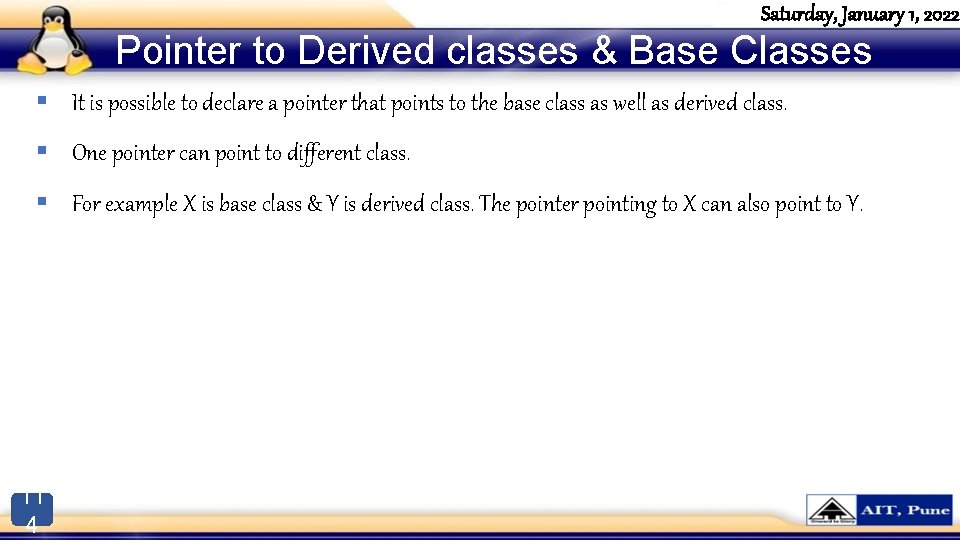
Saturday, January 1, 2022 Pointer to Derived classes & Base Classes § It is possible to declare a pointer that points to the base class as well as derived class. § One pointer can point to different class. § For example X is base class & Y is derived class. The pointer pointing to X can also point to Y. 11 4

// pointers to base class #include <iostream> using namespace std; class Polygon { protected: int width, height; public: void set_values (int a, int b) { width=a; height=b; } }; class Rectangle: public Polygon { public: int area() { return width*height; } }; 115 class Triangle: public Polygon { public: int area() { return width*height/2; } }; int main () Output { Area of Rectangle: 20 Rectangle rect; Area of Triangle : 10 Triangle trgl; Polygon * ppoly 1 = ▭ Polygon * ppoly 2 = &trgl; ppoly 1 ->set_values (4, 5); ppoly 2 ->set_values (4, 5); cout << rect. area() << 'n'; cout << trgl. area() << 'n'; return 0; }
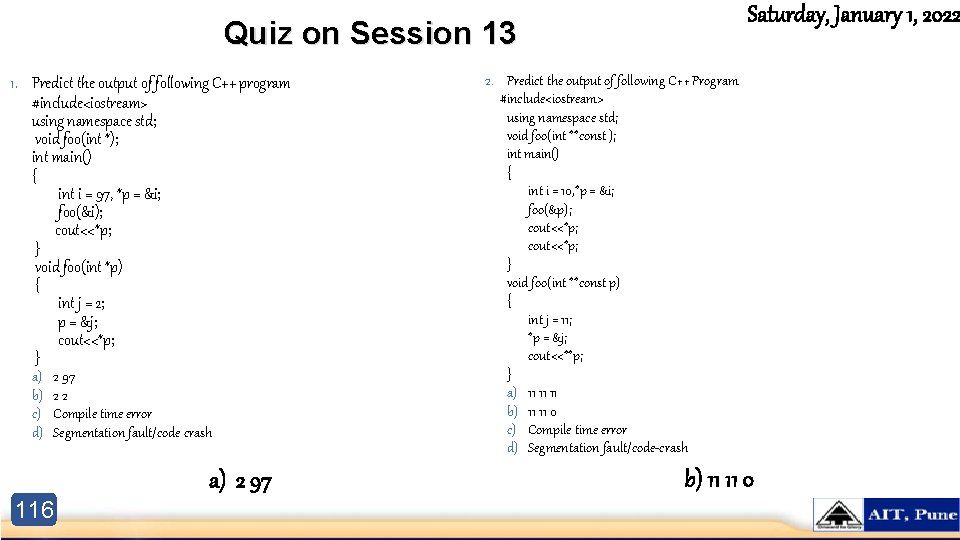
Saturday, January 1, 2022 Quiz on Session 13 1. Predict the output of following C++ program #include<iostream> using namespace std; void foo(int *); int main() { int i = 97, *p = &i; foo(&i); cout<<*p; } void foo(int *p) { int j = 2; p = &j; cout<<*p; } a) b) c) d) 2 97 22 Compile time error Segmentation fault/code crash a) 2 97 116 2. Predict the output of following C++ Program #include<iostream> using namespace std; void foo(int **const ); int main() { int i = 10, *p = &i; foo(&p); cout<<*p; } void foo(int **const p) { int j = 11; *p = &j; cout<<**p; } a) 11 11 11 b) 11 11 0 c) Compile time error d) Segmentation fault/code-crash b) 11 11 0
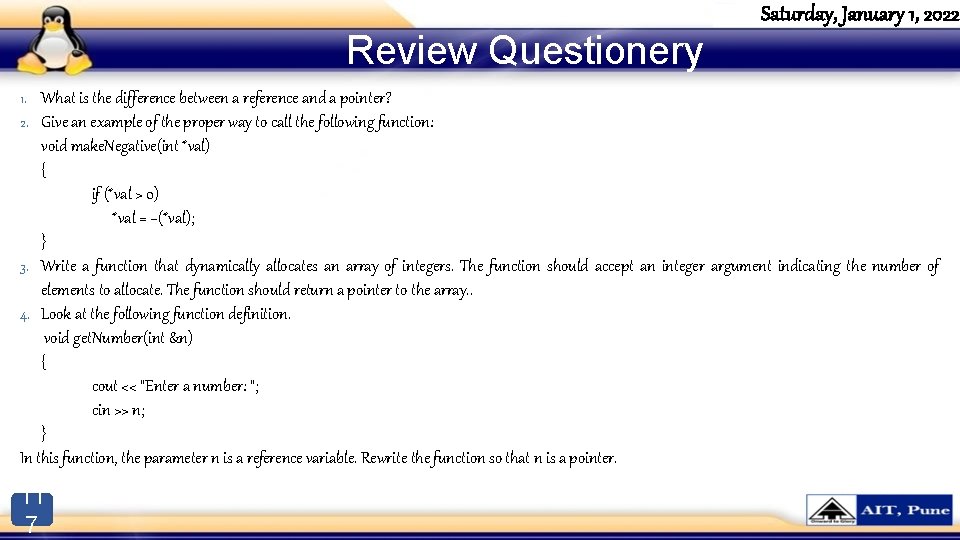
Review Questionery Saturday, January 1, 2022 1. What is the difference between a reference and a pointer? 2. Give an example of the proper way to call the following function: void make. Negative(int *val) { if (*val > 0) *val = −(*val); } 3. Write a function that dynamically allocates an array of integers. The function should accept an integer argument indicating the number of elements to allocate. The function should return a pointer to the array. . 4. Look at the following function definition. void get. Number(int &n) { cout << "Enter a number: "; cin >> n; } In this function, the parameter n is a reference variable. Rewrite the function so that n is a pointer. 11 7
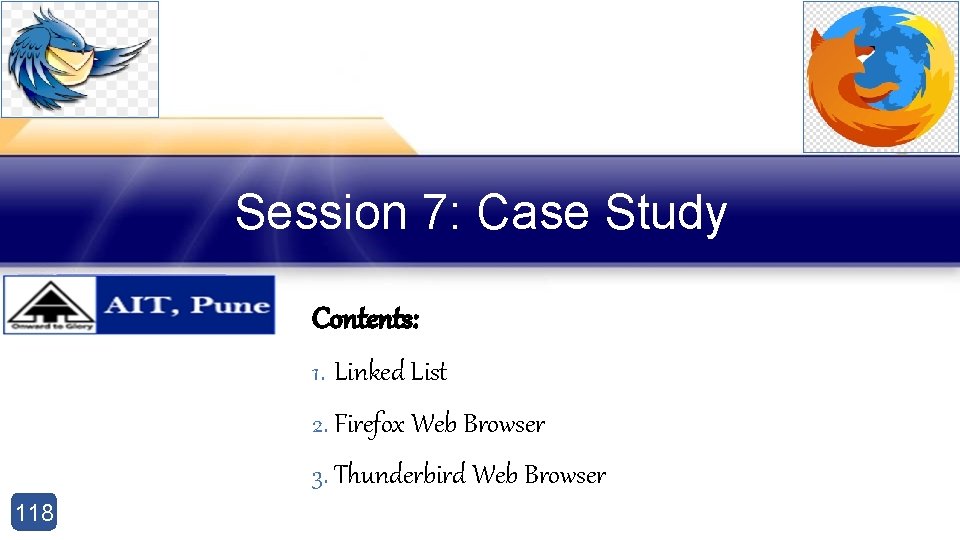
Session 7: Case Study Contents: 1. Linked List 2. Firefox Web Browser 3. Thunderbird Web Browser 118
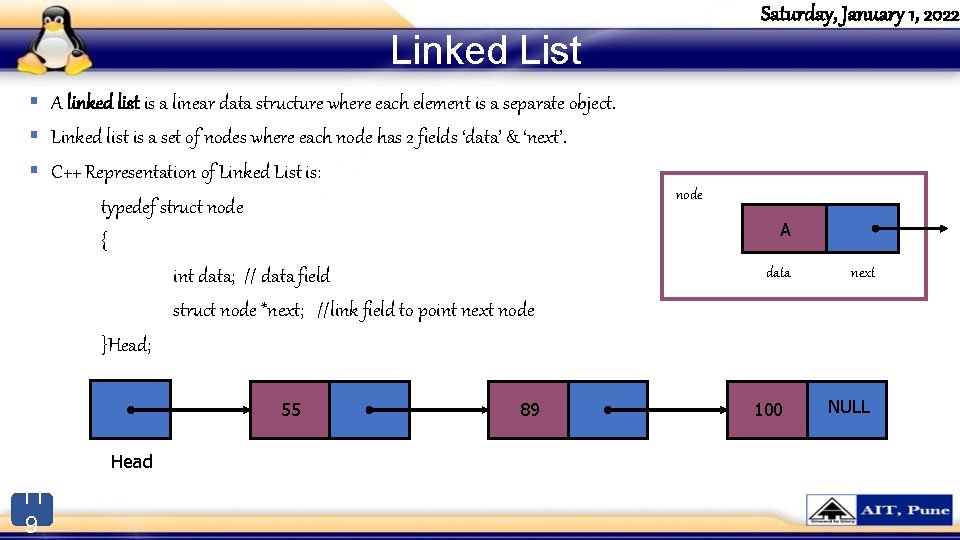
Saturday, January 1, 2022 Linked List § A linked list is a linear data structure where each element is a separate object. § Linked list is a set of nodes where each node has 2 fields ‘data’ & ‘next’. § C++ Representation of Linked List is: typedef struct node { int data; // data field struct node *next; //link field to point next node }Head; 55 Head 11 9 89 node A data 100 next NULL
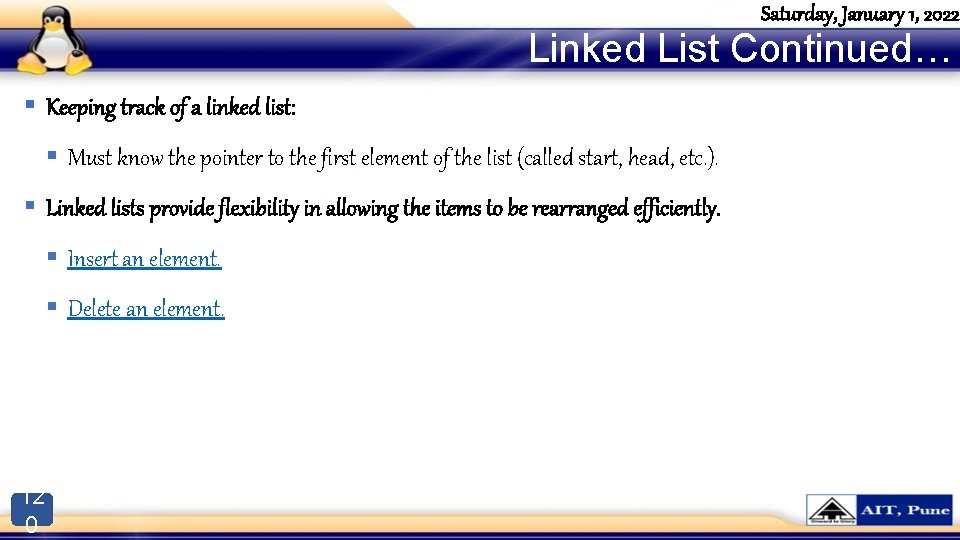
Saturday, January 1, 2022 Linked List Continued… § Keeping track of a linked list: § Must know the pointer to the first element of the list (called start, head, etc. ). § Linked lists provide flexibility in allowing the items to be rearranged efficiently. § Insert an element. § Delete an element. 12 0

Saturday, January 1, 2022 Pseudo-code for insertion struct Node { int data; Node *next; }; //Declare starting (Head) node struct Node *head=NULL; void insert. Node(int n) { struct Node *new. Node=new Node; new. Node data=n; new. Node next=head; head=new. Node; } 121
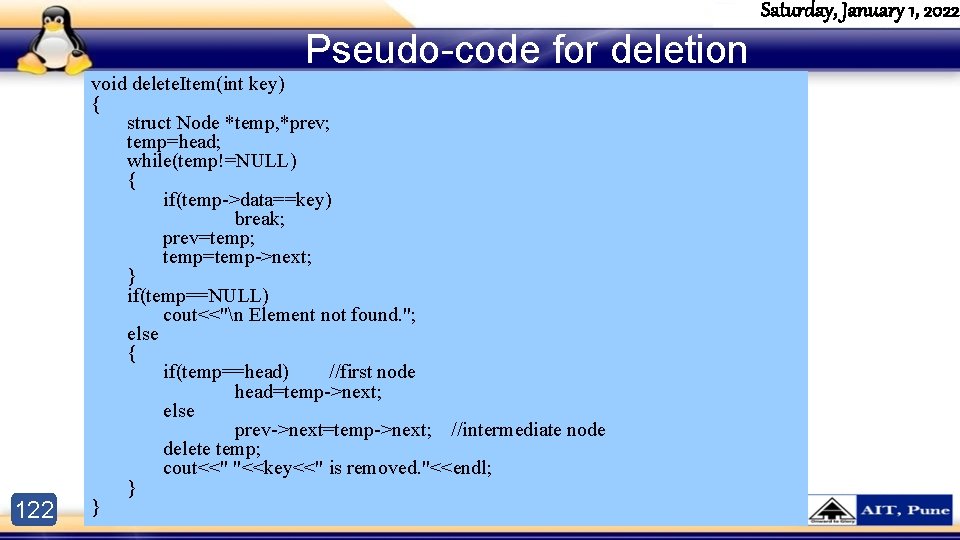
Saturday, January 1, 2022 Pseudo-code for deletion 122 void delete. Item(int key) { struct Node *temp, *prev; temp=head; while(temp!=NULL) { if(temp->data==key) break; prev=temp; temp=temp->next; } if(temp==NULL) cout<<"n Element not found. "; else { if(temp==head) //first node head=temp->next; else prev->next=temp->next; //intermediate node delete temp; cout<<" "<<key<<" is removed. "<<endl; } }
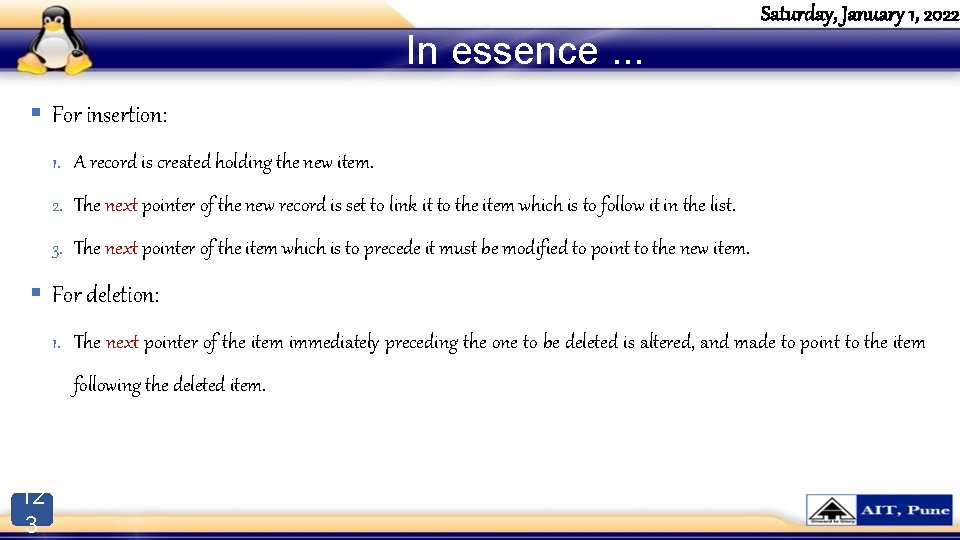
In essence. . . Saturday, January 1, 2022 § For insertion: 1. A record is created holding the new item. 2. The next pointer of the new record is set to link it to the item which is to follow it in the list. 3. The next pointer of the item which is to precede it must be modified to point to the new item. § For deletion: 1. The next pointer of the item immediately preceding the one to be deleted is altered, and made to point to the item following the deleted item. 12 3
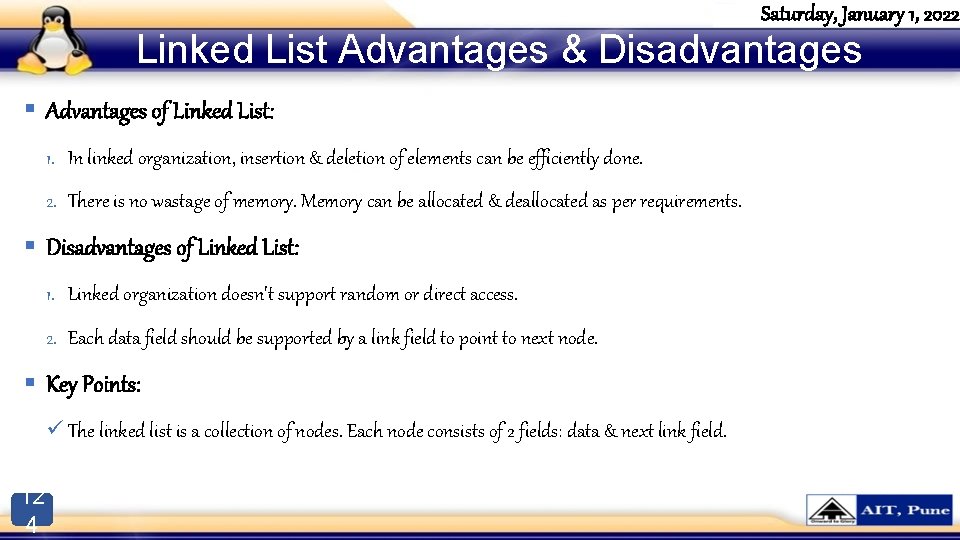
Saturday, January 1, 2022 Linked List Advantages & Disadvantages § Advantages of Linked List: 1. In linked organization, insertion & deletion of elements can be efficiently done. 2. There is no wastage of memory. Memory can be allocated & deallocated as per requirements. § Disadvantages of Linked List: 1. Linked organization doesn't support random or direct access. 2. Each data field should be supported by a link field to point to next node. § Key Points: ü The linked list is a collection of nodes. Each node consists of 2 fields: data & next link field. 12 4
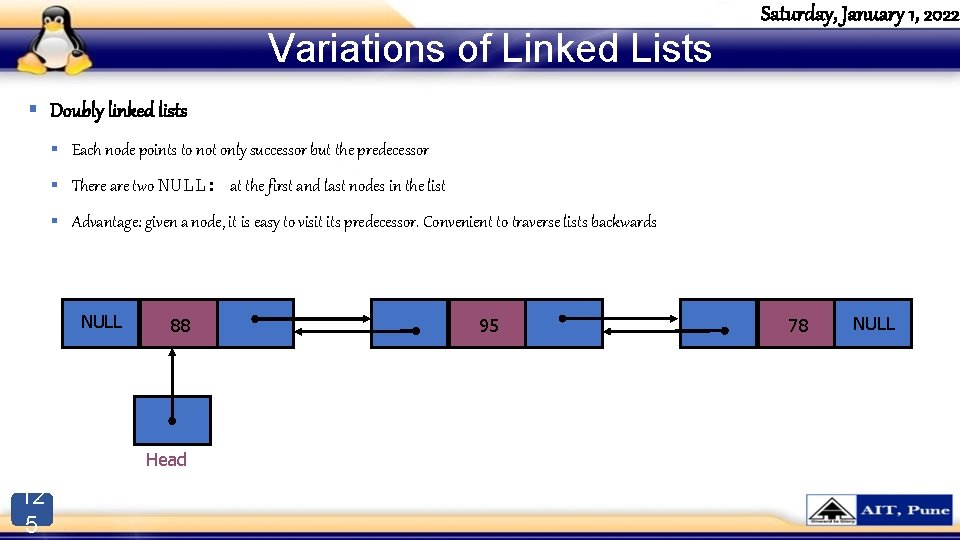
Variations of Linked Lists Saturday, January 1, 2022 § Doubly linked lists § Each node points to not only successor but the predecessor § There are two NULL: at the first and last nodes in the list § Advantage: given a node, it is easy to visit its predecessor. Convenient to traverse lists backwards NULL 88 Head 12 5 95 78 NULL
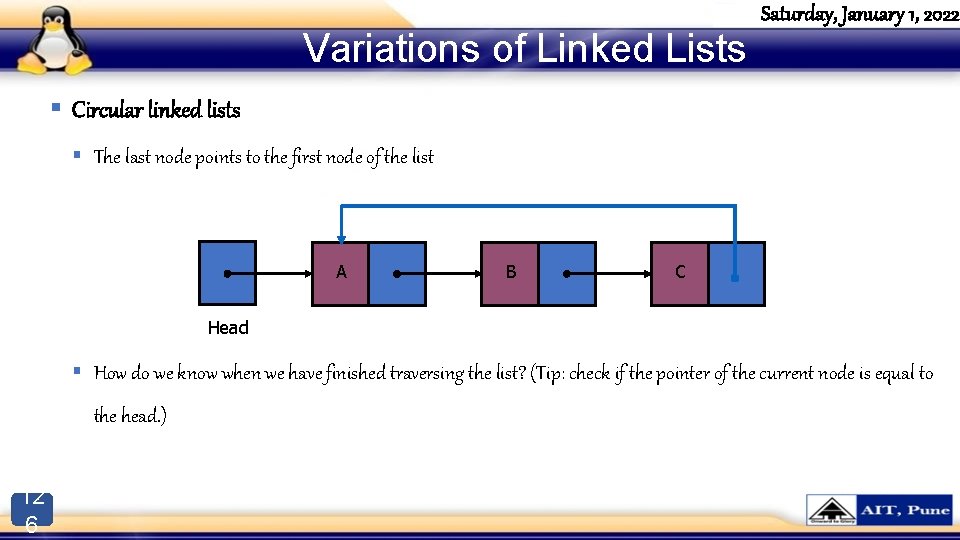
Variations of Linked Lists Saturday, January 1, 2022 § Circular linked lists § The last node points to the first node of the list A B C Head § How do we know when we have finished traversing the list? (Tip: check if the pointer of the current node is equal to the head. ) 12 6
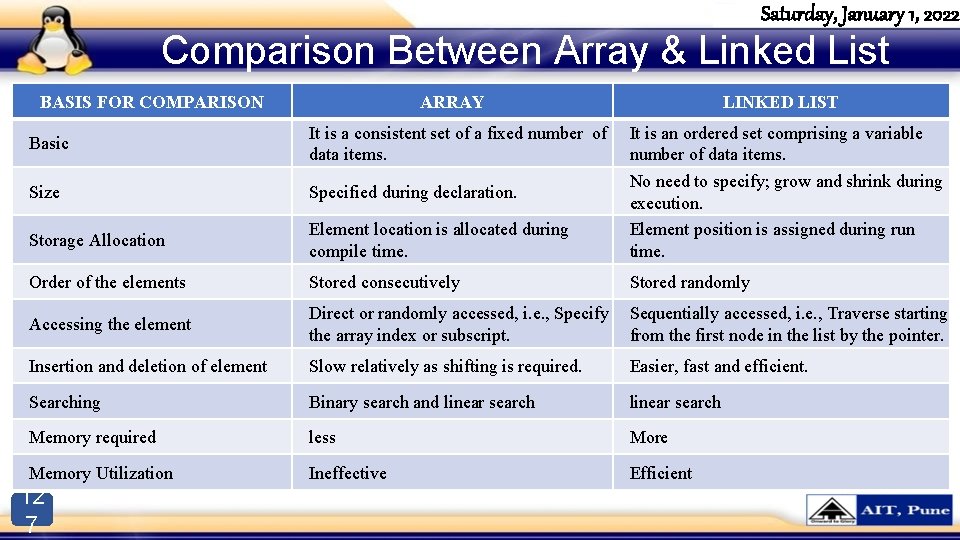
Saturday, January 1, 2022 Comparison Between Array & Linked List BASIS FOR COMPARISON ARRAY LINKED LIST Basic It is a consistent set of a fixed number of data items. Size Specified during declaration. Storage Allocation Element location is allocated during compile time. It is an ordered set comprising a variable number of data items. No need to specify; grow and shrink during execution. Element position is assigned during run time. Order of the elements Stored consecutively Stored randomly Accessing the element Direct or randomly accessed, i. e. , Specify the array index or subscript. Sequentially accessed, i. e. , Traverse starting from the first node in the list by the pointer. Insertion and deletion of element Slow relatively as shifting is required. Easier, fast and efficient. Searching Binary search and linear search Memory required less More Memory Utilization Ineffective Efficient 12 7
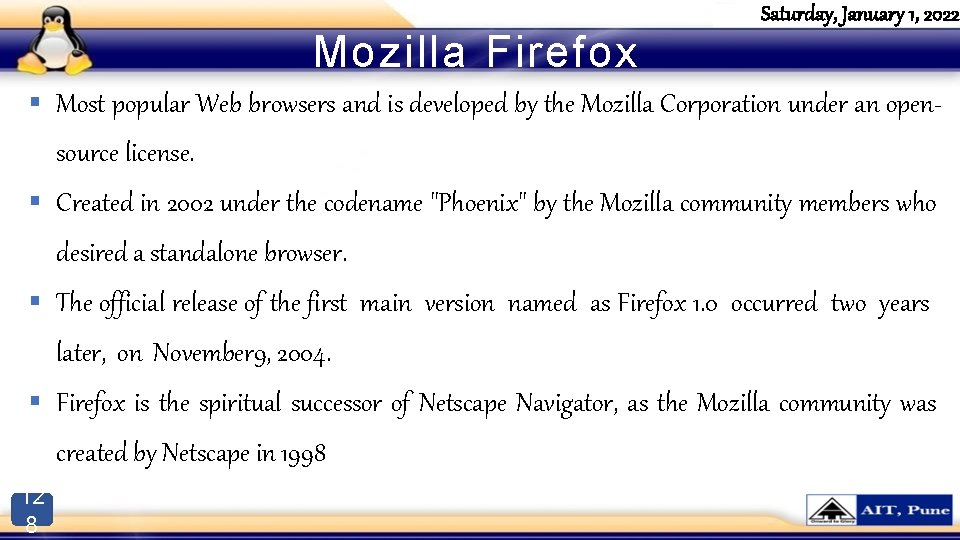
Mozilla Firefox Saturday, January 1, 2022 § Most popular Web browsers and is developed by the Mozilla Corporation under an open- source license. § Created in 2002 under the codename "Phoenix" by the Mozilla community members who desired a standalone browser. § The official release of the first main version named as Firefox 1. 0 occurred two years later, on November 9, 2004. § Firefox is the spiritual successor of Netscape Navigator, as the Mozilla community was created by Netscape in 1998 12 8
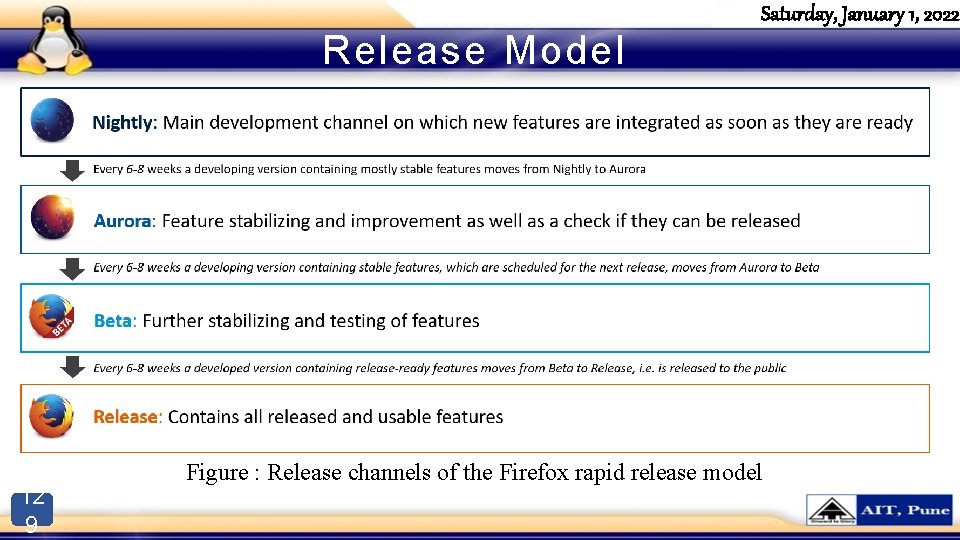
Release Model 12 9 Saturday, January 1, 2022 Figure : Release channels of the Firefox rapid release model
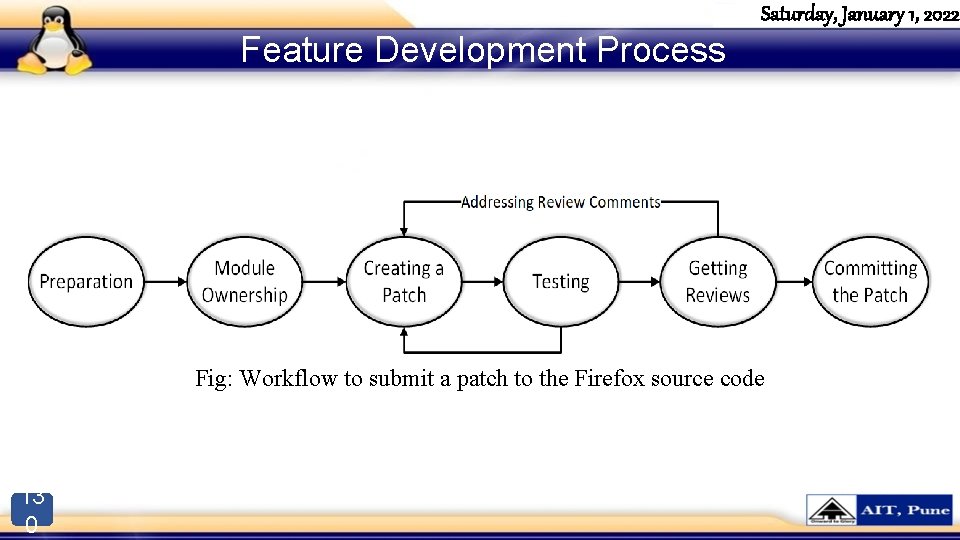
Saturday, January 1, 2022 Feature Development Process Fig: Workflow to submit a patch to the Firefox source code 13 0

Saturday, January 1, 2022 Reference Architecture for Mozilla Firefox § Component Object Model: § The glue that binds all the pieces § Stable, supported bindings for C++ & Java. Script § Interfaces defined in dialect of IDL called XPIDL § Core provides objects to deal with: Files, Memory, Threads, Data structures, Networking, etc. 131
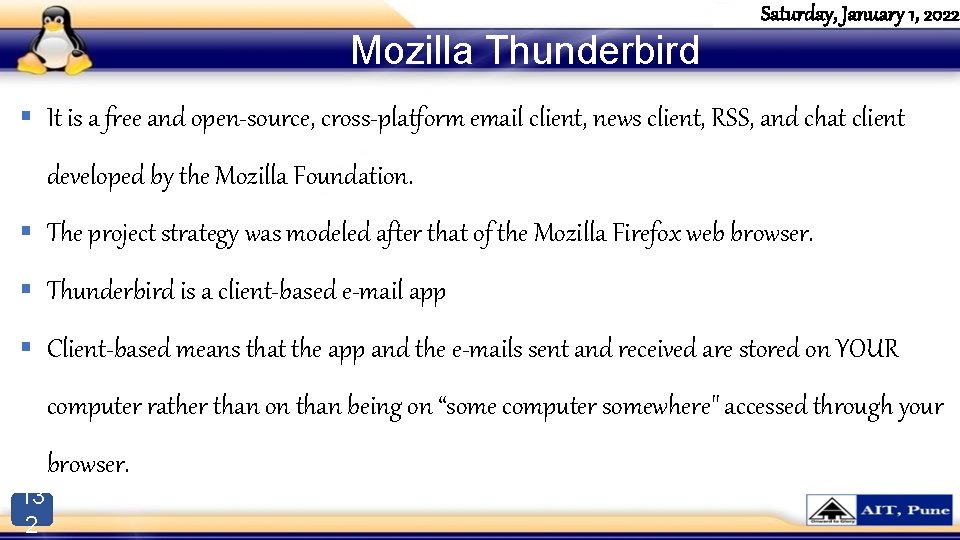
Mozilla Thunderbird Saturday, January 1, 2022 § It is a free and open-source, cross-platform email client, news client, RSS, and chat client developed by the Mozilla Foundation. § The project strategy was modeled after that of the Mozilla Firefox web browser. § Thunderbird is a client-based e-mail app § Client-based means that the app and the e-mails sent and received are stored on YOUR computer rather than on than being on “some computer somewhere" accessed through your browser. 13 2
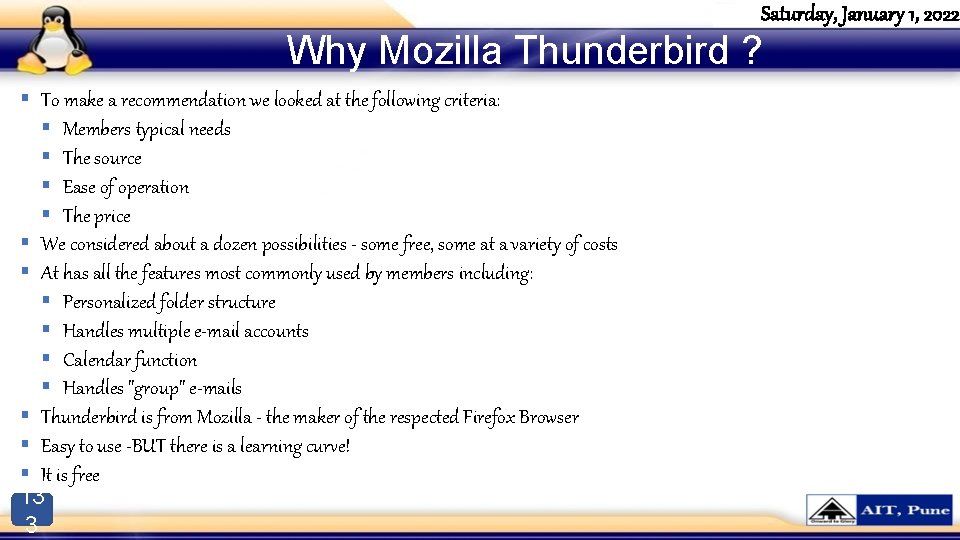
Saturday, January 1, 2022 Why Mozilla Thunderbird ? § To make a recommendation we looked at the following criteria: § Members typical needs § The source § Ease of operation § The price § We considered about a dozen possibilities - some free, some at a variety of costs § At has all the features most commonly used by members including: § Personalized folder structure § Handles multiple e-mail accounts § Calendar function § Handles "group" e-mails § Thunderbird is from Mozilla - the maker of the respected Firefox Browser § Easy to use -BUT there is a learning curve! § It is free 13 3
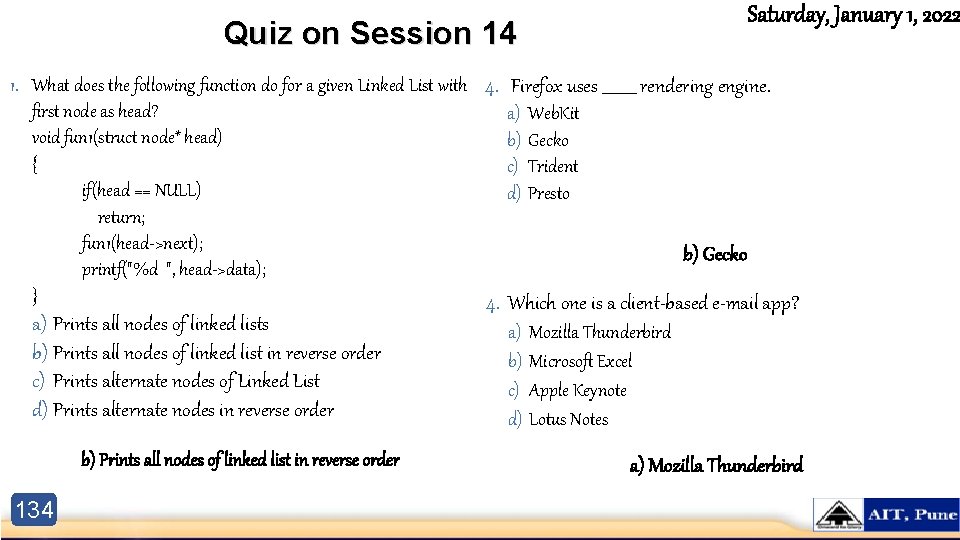
Quiz on Session 14 Saturday, January 1, 2022 1. What does the following function do for a given Linked List with 4. Firefox uses _____ rendering engine. first node as head? a) Web. Kit void fun 1(struct node* head) b) Gecko { c) Trident if(head == NULL) d) Presto return; fun 1(head->next); b) Gecko printf("%d ", head->data); } 4. Which one is a client-based e-mail app? a) Prints all nodes of linked lists a) Mozilla Thunderbird b) Prints all nodes of linked list in reverse order b) Microsoft Excel c) Prints alternate nodes of Linked List c) Apple Keynote d) Prints alternate nodes in reverse order d) Lotus Notes b) Prints all nodes of linked list in reverse order 134 a) Mozilla Thunderbird
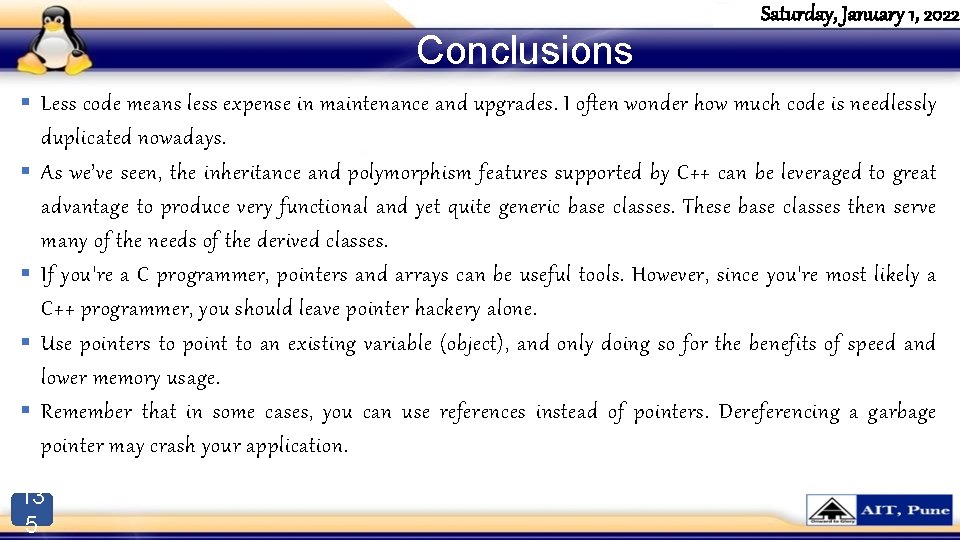
Conclusions Saturday, January 1, 2022 § Less code means less expense in maintenance and upgrades. I often wonder how much code is needlessly § § duplicated nowadays. As we’ve seen, the inheritance and polymorphism features supported by C++ can be leveraged to great advantage to produce very functional and yet quite generic base classes. These base classes then serve many of the needs of the derived classes. If you're a C programmer, pointers and arrays can be useful tools. However, since you're most likely a C++ programmer, you should leave pointer hackery alone. Use pointers to point to an existing variable (object), and only doing so for the benefits of speed and lower memory usage. Remember that in some cases, you can use references instead of pointers. Dereferencing a garbage pointer may crash your application. 13 5

Saturday, January 1, 2022 For any query: Email: kuldeephule@aitpune. edu. in Contact No: 8668277166 Web portal: www. hulekuldeep. weebly. com
- Slides: 135